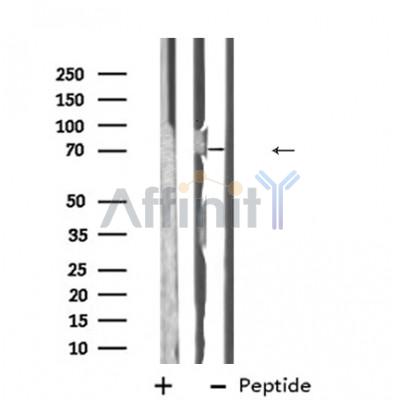ABCG5 Antibody - #DF8401
製品説明
*The optimal dilutions should be determined by the end user. For optimal experimental results, antibody reuse is not recommended.
*Tips:
WB: For western blot detection of denatured protein samples. IHC: For immunohistochemical detection of paraffin sections (IHC-p) or frozen sections (IHC-f) of tissue samples. IF/ICC: For immunofluorescence detection of cell samples. ELISA(peptide): For ELISA detection of antigenic peptide.
引用形式: Affinity Biosciences Cat# DF8401, RRID:AB_2841653.
折りたたみ/展開
Abcg5; ABCG5_HUMAN; ATP binding cassette sub family G (WHITE) member 5 (sterolin 1); ATP binding cassette sub family G member 5; ATP-binding cassette sub-family G member 5; ATP-binding cassette, sub-family G (WHITE), member 5; Sterolin 1; Sterolin-1; STSL;
免疫原
A synthesized peptide derived from human ABCG5, corresponding to a region within the internal amino acids.
- Q9H222 ABCG5_HUMAN:
- Protein BLAST With
- NCBI/
- ExPASy/
- Uniprot
MGDLSSLTPGGSMGLQVNRGSQSSLEGAPATAPEPHSLGILHASYSVSHRVRPWWDITSCRQQWTRQILKDVSLYVESGQIMCILGSSGSGKTTLLDAMSGRLGRAGTFLGEVYVNGRALRREQFQDCFSYVLQSDTLLSSLTVRETLHYTALLAIRRGNPGSFQKKVEAVMAELSLSHVADRLIGNYSLGGISTGERRRVSIAAQLLQDPKVMLFDEPTTGLDCMTANQIVVLLVELARRNRIVVLTIHQPRSELFQLFDKIAILSFGELIFCGTPAEMLDFFNDCGYPCPEHSNPFDFYMDLTSVDTQSKEREIETSKRVQMIESAYKKSAICHKTLKNIERMKHLKTLPMVPFKTKDSPGVFSKLGVLLRRVTRNLVRNKLAVITRLLQNLIMGLFLLFFVLRVRSNVLKGAIQDRVGLLYQFVGATPYTGMLNAVNLFPVLRAVSDQESQDGLYQKWQMMLAYALHVLPFSVVATMIFSSVCYWTLGLHPEVARFGYFSAALLAPHLIGEFLTLVLLGIVQNPNIVNSVVALLSIAGVLVGSGFLRNIQEMPIPFKIISYFTFQKYCSEILVVNEFYGLNFTCGSSNVSVTTNPMCAFTQGIQFIEKTCPGATSRFTMNFLILYSFIPALVILGIVVFKIRDHLISR
種類予測
Score>80(red) has high confidence and is suggested to be used for WB detection. *The prediction model is mainly based on the alignment of immunogen sequences, the results are for reference only, not as the basis of quality assurance.
High(score>80) Medium(80>score>50) Low(score<50) No confidence
研究背景
ABCG5 and ABCG8 form an obligate heterodimer that mediates Mg(2+)- and ATP-dependent sterol transport across the cell membrane. Plays an essential role in the selective transport of dietary plant sterols and cholesterol in and out of the enterocytes and in the selective sterol excretion by the liver into bile. Required for normal sterol homeostasis. The heterodimer with ABCG8 has ATPase activity.
N-glycosylated.
Cell membrane>Multi-pass membrane protein. Apical cell membrane>Multi-pass membrane protein.
Strongly expressed in the liver, lower levels in the small intestine and colon.
The Walker motif (consensus sequence G-X-X-G-X-G-K-[ST]-T) is expected to bind ATP. Within this motif, the conserved Lys is essential for transport activity mediated by the heterodimer with ABCG8.
Belongs to the ABC transporter superfamily. ABCG family. Eye pigment precursor importer (TC 3.A.1.204) subfamily.
研究領域
· Environmental Information Processing > Membrane transport > ABC transporters.
· Organismal Systems > Digestive system > Fat digestion and absorption.
· Organismal Systems > Digestive system > Cholesterol metabolism.
参考文献
Application: WB Species: human Sample:
Application: WB Species: cows Sample: Liver tissue
Restrictive clause
Affinity Biosciences tests all products strictly. Citations are provided as a resource for additional applications that have not been validated by Affinity Biosciences. Please choose the appropriate format for each application and consult Materials and Methods sections for additional details about the use of any product in these publications.
For Research Use Only.
Not for use in diagnostic or therapeutic procedures. Not for resale. Not for distribution without written consent. Affinity Biosciences will not be held responsible for patent infringement or other violations that may occur with the use of our products. Affinity Biosciences, Affinity Biosciences Logo and all other trademarks are the property of Affinity Biosciences LTD.



